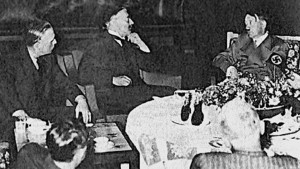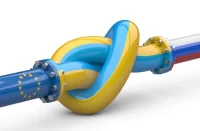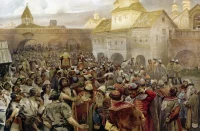For the last months international politicians and media outlets used to compare the contemporary situation in Europe with the eve of WWI. Meanwhile the political and social processes we witness today in the region is much more resembling the late 1920s – early 1930s, the period when the West was fostering an anti-Russian force in Germany.
Of course, today’s Ukraine cannot be compared to Hitler’s Third Reich yet. But first blow is half the battle. Fuhrer too was once an unknown ex-corporal of the German army preaching xenophobia and revenge.
It’s an open secret that Adolf Hitler was credited by the United States. The US investments in Germany, first of all in military-industrial complex, were so significant that by 1933 the United States controlled key branches of Germany’s economy, as well as large banks such as Deutsche Bank, Dresdner Bank, Donut Bank etc.
As soon as international big money-bags decided to count on Hitler, their funds started pouring lavishly into his party. Thanks to the extensive donations from Frotz Thyssen’s United Steelworks (Vereinigte Stahlwerke AG), I.G. Farbenindustrie AG (Interessen-Gemeinschaft Farbenindustrie AG) and mining industry tycoon Emil Kirdorf the party received 6,4 million votes in September 1930 to become the second largest in Reichstag. Hjalmar Schacht, a German economist, banker, liberal politician, and co-founder of the German Democratic Party, became the key connecting link between German industry and foreign donors.
British business also started to give donations to Fuhrer and his Nazi party. On January 4, 1932 Montague Norman, the Governor of the Bank of England from 1920 to 1944, met Hitler and German Chancellor Franz von Papen to conclude a secret accord on providing funds for the National Socialist German Workers’ Party. The both Dulles brothers from the United States were present at the meeting, the fact which their biographers prefer to ignore (John and Allen were politically connected Wall Street lawyers, servants of corporate power, who led the United States into an unseen war that decisively shaped today’s world). . As a result of lavish donations from abroad, the Nazi Party has eventually won the federal elections in March 1933 (by that time Hitler was already appointed as German’s Chancellor).

The new German government was treated extremely favorably by the US and UK ruling class. Western democracies kept silent when Berlin refused to pay reparations. Hjalmar Schacht, President of the Reichsbank and Minister of Economics, went to the United States in May 1933 to meet President Roosevelt and leading Wall Street bankers. Germany was granted a $1 billion credit. In June, during a visit to Norman in London, Schacht requested an additional $2 billion loan. Previous German debts were restructured or simply written off. Thus, the Nazis got preferences that the previous government could not even imagine.
In summer 1934, Britain signed the Anglo-German Transfer Agreement, which became one of the foundations of British policy towards the Third Reich, and by the end of the 1930s, Germany developed into Britain’s primary trading partner. Schroeder’s bank turned into the Germany’s and Great Britain’s main agent, and in 1936, its New York branch merged with a Rockefeller holding to create the investment bank «Schroeder, Rockefeller and Co.», which Time magazine described as “the economic booster of the Rome-
The ‘Secret Memorandum’ was issued by Adolf Hitler in August 1936. The memorandum went out only to a few senior Nazi leaders and its contents – information about the Four-Year Plan – were formally announced to the party faithful in September 1936 at the party rally in Nuremberg. The Secret Memorandum stated that in four years Germany was to have capable combat-ready armed forces and its economy was to be mobilized to meet the needs of war. As he admitted himself, Hitler viewed foreign credit as the financial basis for his four-year plan.
In August 1934, American oil giant Standard Oil purchased 730,000 acres of land in German and built large oil refineries that supplied the Nazis with oil. At the same time, the United States secretly provided Germany with the most modern equipment for airplane factories, which would soon produce German aircraft. Germany received a large number of patents from American firms Pratt and Whitney, Douglas, and the Bendix Corporation, and the «Junkers-87» dive-bomber was built using purely American technology. As the war broke out the monopolies stuck to the good old tried-and-true rule – nothing personal, only business. By 1941, when the Second World War was in full swing, American investment in the German economy totaled $475 million: Standard Oil invested $120 million alone, General Motors — $35 million, ITT — $30 million, and Ford — $17.5 million.
What motivated the interest of Western business in the growing might of Nazi Germany? The goal was to direct Hitler to the East and invade Russia. The conquest of Lebensraum («living space») was for Hitler and the rest of the National Socialists the most important German foreign policy goal. At his first meeting with the top generals and admirals of Reich on February 3, 1933, Hitler spoke of «conquest of Lebensraum in the East and its ruthless «Germanization» as his ultimate foreign policy objectives. For Hitler, the land which would provide sufficient Lebensraum for Germany was the Soviet Union, which for Hitler was both a nation that possessed vast and rich agricultural land and was inhabited by what Hitler saw as Slavic Untermenschen (sub-humans) ruled by what he regarded as a gang of blood-thirsty, but grossly incompetent Jewish revolutionaries. These people were not Germanizable in his eyes; only the soil was. British establishment was happy as Hitler stated his goals. Their hearts were also filled with gladness as they learned that he wrote in his Mein Kampf:
«We National Socialists consciously draw a line under the direction of our foreign policy war. We begin where we ended six centuries ago. We stop the perpetual Germanic march towards the south and west of Europe, and have the view on the country in the east. We finally put the colonial and commercial policy of the pre-war and go over to the territorial policy of the future. But if we speak today in Europe of new land, we can primarily only to Russia and the border states subjects him think».
The policy of appeasement was implemented by Western countries in the 1930s against the background of financial and economic cooperation of Wall Street and City business with Nazi Germany.

In October 1930 Germany withdrew from both the Conference for the Reduction and Limitation of Armaments of 1932–1934 and the League of Nations. In March 1936 Hitler ordered his troops to openly re-enter the Rhineland demilitarized under the Versailles Treaty. In March 1938 Austria was annexed. The West did not react; it looked at what was happening coldblooded. Fall Grün (Operation Green), a German military plan to occupy Czechoslovakia, was approved by Hitler in December 1937. The execution of Operation was called off after the Munich Pact was concluded between England, France, Italy and Nazi Germany on September 30, 1938. But Hitler never refused his intention as he was putting the signature along with Arthur Neville Chamberlain, Édouard Daladier and Benito Mussolini. On October 21 he ordered to start preparations for final onslaught to annex the rest of Czechoslovakia and the Klaipeda Region (also known as the Memel Territory) which was part of Lithuania since 1923. In March 1939 Germany delivered an ultimatum to Poland demanding renegotiation of the Danzig. The Polish Corridor (also known as Danzig Corridor, Corridor to the Sea or Gdansk Corridor) was a territory located in the region of Pomerelia (eastern Pomerania, formerly part of West Prussia), which provided the Second Republic of Poland (1920–1939) with access to the Baltic Sea, thus dividing the bulk of Germany from the province of East Prussia. The Free city of Danzig (now the Polish city of Gdansk) was separate from both Poland and Germany.
But Memel and Danzig were not the main missions to make Fuhrer satisfied as they were accomplished. He could clearly see that nobody in the West had any intention to stand in his way. On April 1939 he secretly ordered Poland to be attacked on September 1.
With the seizure of Czechoslovakia the Hitler’s duel-track policy was an open secret even for the most shortsighted politicians and diplomats. The Soviet Union still cherished hope to build a collective system of security in Europe. It managed to make London and Paris start talks on creating a really effective alliance to counter the aggressor. But the talks showed the Western partners were reluctant to hinder the Hitler’s movement to the East. Sir Alexander Cadogan (Permanent Under-Secretary at the Foreign Office) cited Chamberlain saying he would rather resign the premiership than conclude an agreement with the «Soviets».
When the Germany attacked Poland and the Second World War started, Western leaders pointed finger at the Soviet Union and Germany signing the Non-Aggression Treaty of August 23, 1939. Supported by a choir of propaganda masters and partial historians dancing to their tune, they said it was not the Western appeasement policy, but rather the USSR-Germany agreement that provoked the war.
Neither London, nor Washington, nor Paris want to hear the truth about those events, no matter they signed the Nuremberg Trial verdict that found Germany guilty of grave crimes and violations of international law and the laws of war. One can clearly see what’s behind it. The political and financial circles of the United States, Great Britain and France were too much involved in fostering the fascist regime and connived at what it did while sticking to the appeasement policy. They incited Hitler to move East.
The West does not recognize the responsibility for supporting the Hitler’s regime, and it refuses to admit its guilt. It does its best to prevent the Russia’s return on world stage as a leading actor. It fosters the ulcer of Nazism and xenophobia emerging right in front of its eyes. To hide the truth it circulates the Washington-invented and Europe-inculcated story about «Russian aggression» against Ukraine. Russia is demonized and provoked into direct intervention to become a party to the Ukraine’s internal conflict.
I will repeat that the Kiev junta is not in the same league with the Hitler’s regime. But history proves that the ulcer of Nazism mixed with the poisonous substance of Russophobia grows rapidly, and sooner or later it will be on its own beyond the control of those who encouraged it. The slogan «Ukraine above all» sound very much like a remake of German Nazi «Deutschland über alles», («Germany above all»). It inspires the crimes committed by Ukraine’s rulers in Novorossia.
Prof. Yuri Rubtsov is the Ph.D. (History) who lectures at the Military University (Moscow).
Source in Russian: Strategic Culture Foundation
The original text was adapted by ORIENTAL REVIEW.
*) In Greek myth, dragon’s teeth feature in the legends of the Phoenician prince Cadmus and in Jason’s quest for the Golden Fleece. Their teeth, once planted, would grow into fully armed warriors. The phrase “to sow dragon’s teeth” is widely used as a metaphor to refer to doing something that has the effect of fomenting turmoils.














please,more articles like these to feed those who only got the censored version of history printed in the textbooks.which reminds me,a new ‘episode’ would be welcome.
Pingback: New Europe, New NATO… | YERELCE